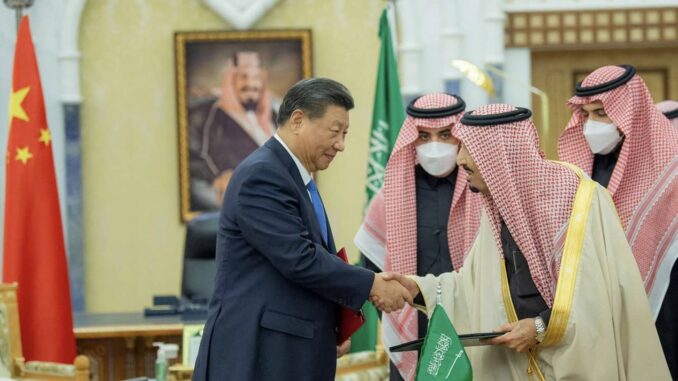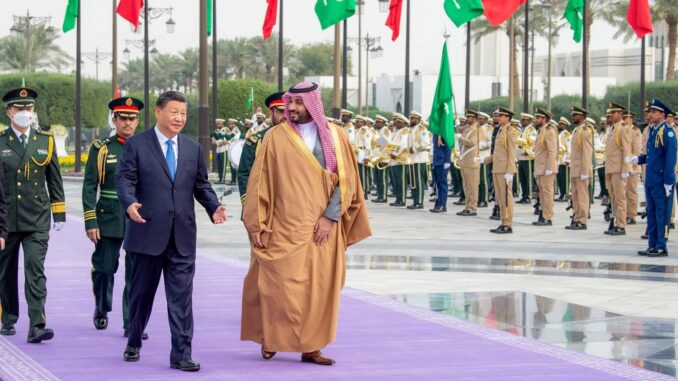by January 2023

Chinese President Xi Jinping meets with Saudi King Salman bin Abdulaziz in Riyadh, Saudi Arabia December 8, 2022. Photo credit: REUTERS
The Biden administration does not view US–China competition in the Middle East as a zero-sum prize for one side to enjoy at the other’s expense. This measured response to China’s growing influence could change, however; outlined below are factors that could shift US policy toward great power confrontation in the region.
China’s President Xi Jinping paid a three-day visit to Saudi Arabia in December 2022, which included a bilateral meeting with Saudi Arabia, a Gulf–China summit, and an Arab–Chinese summit. In all, Xi held bilateral meetings with nearly 20 Arab leaders. President Xi and Crown Prince Muhammad bin Salman signed an ambitious Chinese–Saudi partnership pact guaranteeing cooperation in finance, innovation, science and technology, aerospace, energy, language, and culture. This was followed by similarly lofty agreements at both summits, pledging that China and its Middle Eastern partners would significantly expand cooperation and commercial ties across the board.
China’s spokesperson hailed Xi’s visit as “epoch-making.” Beijing’s state media described the visit as “China’s largest and highest-level diplomatic action with the Arab world since the founding of the People’s Republic of China.”
Part of China’s triumphalism was likely designed to deflect attention away from protests at home around its zero-COVID-19 policies. With domestic challenges mounting, China’s leaders increasingly crave visible symbols of respect abroad. Xi’s reception in Saudi Arabia stirred national pride at home at a moment when Beijing was seeking to shift focus away from domestic discontents.
However, it wasn’t just inside China where Xi’s visit garnered attention. Commentators across the Middle East also marked Xi’s visit as signaling a geopolitical shift from American regional dominance to greater multipolarity. In the US, however, Xi’s visit did not attract significant media attention. In fact, it hardly registered in the American media, which then was focused on the prisoner swap of an American woman basketball player for a Russian arms dealer and the repercussions of the US midterm election results.
Asked to comment on the significance of Xi’s visit, a White House spokesperson observed, “We are mindful of the influence that China is trying to grow around the world.” The State Department spokesperson was similarly circumspect, noting that it is not for the US to “comment on bilateral relationships between any two countries when we are not a party to them.” He went on to highlight that the Biden administration is not forcing any countries to choose between the US and China but rather seeks to give countries options for how best to pursue their interests.
Part of America’s circumspection on Xi’s trip may reflect a desire not to inflate the significance of the inroads Xi made in the region. Under President Biden, America’s approach toward Saudi Arabia has also shifted, viewing it less as a prize worth pursuing and more as a complicated partner who must be managed.

To be sure, the US has been working hard to stave off Chinese activism in specific areas, such as in regional telecommunications infrastructure and in gaining greater control of ports in strategic waterways. Any Chinese efforts to limit American access to the region or undermine its traditional security role would invite confrontation; yet so far, China’s involvement in the region is not threatening America’s ambitions. As White House Middle East Coordinator Brett McGurk recently concluded, “Thus far, we are not seeing the type of relationships [between China and Gulf countries] that is getting in the way of what we’re working here to build.”
Although the current zeitgeist in Washington seems to treat any advance by China in the world as a threat to American leadership, the Biden administration—publicly, at least—does not project a similar sense of alarm about China’s growing influence in the Middle East. There are multiple potential explanations for this relatively more balanced framing.
First, the Biden administration has adopted a global posture of seeking to outcompete China for influence by providing a more attractive offering to partners, not by strong-arming partners into turning away from China. Even as President Biden often invokes a global struggle between democracies and autocracies for influence in the 21st century, he and members of his administration also regularly call for the US and China to compete without resorting to conflict. The Biden administration does not envision any near-term resolution to the US–China great power competition. Instead, American policymakers speak of the need for the US to outperform China over the long term.
Second, the Biden administration has diminishing expectations for what it can achieve with Saudi Arabia. US–Saudi relations have cooled in recent years in both directions. President Biden had entered office with strong views on Yemen and on the crown prince’s alleged role in the murder of Washington Post columnist Jamal Khashoggi. He later sought to engage the Saudi leadership during a visit in July 2022. Saudi Arabia’s decision in October 2022 to lead a two million barrel per day cut in OPEC+ production quotas, three months after Biden’s visit and one month before US midterm elections that were being framed around inflation, widened the growing gap between both countries. In this environment, Saudi leaders would be delusional to think that warming ties with China will generate any leverage in their relationship with the US.
Third, there is no real near-term risk of China displacing America’s security role in the region, nor any credible indications that China aspires to do so. The US operates a constellation of military bases across the region. China maintains a small military presence in Djibouti, alongside French, Italian, Japanese, and American military installations there. China is increasing defense exports to the region, but the volume pales in comparison to US exports of defense equipment and services. China is increasing its naval presence and joint exercise with Saudi and other forces, but again, the level of Chinese presence does not compare to American levels. The invocation by American military leaders of the great powers’ competition to explain the importance of sustaining a strong presence in the region should not be interpreted as signaling an alarm about China’s growing military profile. Rather, it should be understood as a recognition that American military leaders are vigilant to China-related risks in the Middle East, just as they are in every other geographic and functional domain.
Fourth, America is gaining greater strategic room for maneuver in the Middle East while China’s requirements are becoming more linked to the region. In 2021, 72% of China’s crude oil consumption was imported, with roughly 50% coming from the Middle East. China is increasingly dependent on secure flows of energy from the region and on preserving access through the many chokepoints that its energy supplies must transit en route to China, including the Persian Gulf, the Gulf of Oman, the Red Sea, the Bab al-Mandeb Strait, the Strait of Hormuz, the Malacca Strait, and the South China Sea. China is now the world’s top importer of oil. America is the world’s largest oil producer. As counterterrorism recedes in America’s hierarchy of foreign policy priorities, the US gains greater flexibility in its approach to the region.
Fifth, American and Chinese vital interests in the Middle East are not in fundamental tension. China has maintained a narrow definition of its interests in the Middle East. Beijing seeks to preserve unimpeded access to energy and markets, protect its citizens residing in the region, and ensure that its relationships in the region do not cast a negative light on China in the Muslim or developing world. China does not have any evangelical or ideological ambitions in the region, unlike the US, which has seesawed in the past in its prioritizing its promotion of democracy. Both American and Chinese interests demand peace and stability in the Middle East and a reduction of threats emanating from it, and China should invest in the region in ways that expand oil output or improve human development, supporting both American and Chinese strategic objectives.
None of this is meant to suggest that the US is—or should be—sanguine about China gaining greater strategic influence in the Middle East. It is merely meant to underline that the Biden administration does not appear to be panicked about Xi’s recent visit to Saudi Arabia, or more broadly about China’s growing diplomatic, security, and economic investments in the region.
Thus far, America has responded with a measured approach of delineating specific Chinese actions that would cause concern. American policymakers judge they will have greater capacity to exercise influence by tailoring concerns narrowly (e.g., around technology and critical infrastructure) than by making blanket demands upon regional powers to spurn Chinese investments. A range of factors will inform whether the Biden administration sustains such a measured approach. These include how well the approach works in limiting China’s involvement in 5G/6G telecommunications infrastructure, restricting China’s control of strategically sensitive ports, and disincentivizing China from directly challenging America’s traditional security role in the region. America’s approach also will be influenced by demand signals from the rest of the region and by the outcome of America’s 2024 presidential election.
Ultimately, the trajectory of US–China competition in the Middle East may hinge on whether China continues to narrowly define its ambitions. So long as both major powers conceive of their vital interests in compatible ways and the region welcomes both major powers to make complementary contributions to security and development, then risks of direct confrontation remain low. If China decides that the status quo is no longer tolerable, if US–China confrontation intensifies elsewhere and bleeds into the region, or if countries in the region privilege China’s priorities at America’s expense, then risks of great power confrontation in the region may need to be revisited.



Leave a Reply
You must be logged in to post a comment.